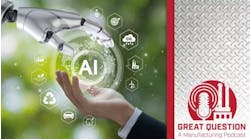Compressed air: Capital investment or paid utility?
By Mike Bacidore, editor in chief at Control Design
While compressed air is used in more than 70% of manufacturing activities, the true costs and behind-the-scenes maintenance required to keep this critical utility efficient, available and in tip-top shape are often poorly understood or neglected. Fortunately, digital technology already is helping to not only optimize compressor efficiency but also to flag equipment issues that can lead to air quality problems or unscheduled downtime.
Wayne Perry, senior technical advisor for Kaeser Compressors, explained his company’s early endeavors in the digital world at Smart Industry 2017. “Three-quarters of a compressor’s lifecycle cost is in electricity; maintenance and the purchase price comprise the rest,” explained Perry. “Over a 10-year lifecycle, you’ll spend as much in maintenance as the equipment costs,” he said. “But we’re digitally transforming all of this.”
Across the industry, smarter controls are enabling improvements in compressor performance. Kaeser’s Sigma Control 2, for example, monitors critical parameters; automatically shuts units down to prevent damage; stores alarm and operating history so a technician can download the alarms that led up to a problem; records ambient temperature; and sends maintenance reminders, such as when it’s time to change the air filter.
With a next-generation system master controller such as Kaeser’s Sigma Air Manager 4.0, compressed-air use can be measured and managed, including real-time reaction to demand changes, remote system monitoring, more stable operating pressure and lower energy costs. “The Sigma Air Manager 4.0 also contains a digital twin of the compressed air system,” said Perry. “Our controller takes all the information that’s stored and derives the possible control strategies. Then it picks the most efficient one and implements it. It will also change it if it determines it is no longer using the most optimal strategy.” Kaeser’s computers in Koberg, Germany, also receive the data feed and constantly refine the algorithms.
Poor air quality is a killer for equipment. It can deteriorate valves and pneumatic tools. “If you have bad particulates or water, those lead to high maintenance expenses and poor product quality,” said Perry. “Contaminants cause increased scrap—say, if you get some oil in there and you’re doing injection molding. The controller also monitors and controls the filters and the dryers and will alert someone when components aren’t working properly. All of that information can be fed back and presented to the user.”
For equipment reliability, everyone is looking for the Maytag repairman, joked Perry. “It’s difficult to do that, unless you’re operating the system the most efficiently and appropriately for the demand on the system,” he explained. “I’ve gone into plants where they’ve collected reams and reams of data, but they don’t know what to do with it. Being able to turn that data into usable information is what makes the analysis valuable.”
Compressed air as a service
Compressed-air systems are normally sold as capital equipment. But what if compressed air were sold as a service and bought at a fixed price? “What if it were managed and operated by someone who knows what to do with the data?” asked Perry. “A lot of companies would rather not. But we do more and more air utilities, where we own, operate and maintain the compressors, and we sell compressed air by the cubic foot.”
Kaeser puts in redundancies, Perry explained, so, if something fails, the backup comes on. “There’s no capital expense,” he said. “You’ve got guaranteed air pressure and air quality at a fixed price. We couldn’t do what we do if we weren’t able to monitor the equipment. We know how to interpret the data. We know what’s critical and what’s not.”
The whole idea of a compressed-air utility is spreading, especially in cement plants. For one company, Kaeser was able to help it to reduce compressed-air energy requirements by more than 30%. “We did nothing but control the compressors the way they needed to be controlled for the demand,” explained Perry. “The energy savings on the plants paid for the air utility and allowed them to put their maintenance people on more productive activities.”
Connectivity was the key, said Perry. “Digital transformation must be strategic,” he explained. “Do it with a big vision. Understanding customers’ needs and interests is really critical to be able to provide what they need to get their jobs done.”


